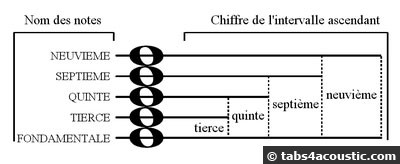The building of chords
Basics required for this lesson : Harmony for Dummies : Intervals,
Practice this lesson : None
To understand how chords are built, there is a few rules to know:
- a chord consists of at least 3 notes
- the chords that have three notes (most common) are called triads
- chords with 4 notes are much rarer, they are called tetrads
Chords with 3 notes
Basics :
- The triads are composed of the key note, the third, and the fifth.
- The root note gives its name to the chord
- The third gives the color of the chord
If we take for example the C chord, there are 4 different possible forms all created with the key note, the third, and the fifth: C major, C minor, C augmented and C diminished. It is the third that gives the "color" of the chord, so if the third is minor, the chord is minor or diminished, if the third is major, the chord is major or augmented.
As a reminder (see course on the intervals):

Intervals
To find the notes of the C major chord, you must calculate the half tones between the root note and the major third, and between the root note and the fifth. This gives very concretely:
- The root note: C
- The major third: E (4 half tones above the root note, giving C-C #-D-D #-E. Review the course on the intervals for details)
- The fifth (perfect): G (3 ½ tones higher than the root note C-C #-D-D #-E-F-F #-G)
The C chord C is composed of three notes: C, E, G. (C-E-G) and in fact, the chord is made this way on the guitar: x32010 (xCEGCE).
Summary of the four possibilities for the C chord:
- C Major: major third and minor third (C-E-G)
- C minor: minor third, major third. (C-E # and G)
- C aug: two successive major thirds(C-E-G #)
- C dim: two successive minor thirds (C-D # and A #)
In the end, this is equivalent to the key note, major or minor third and a perfect fifth, augmented or diminished. From there you can build any chord that has three notes. As you can see, everything is a matter of intervals (1 / 2 tones) between the notes, a question of logic.
Suspended chords are chords with three notes, consisting of the key note, a perfect fourth and a perfect fifth. (They are called "sus")
Chords with two notes
These are triads in which we removed the third. They are therefore solely composed of the key note and a fifth (perfect, diminished or augmented).
Using our example in C, this gives:
- With a perfect fifth (C5): C and G,
- With a diminished fifth (C5 #): C and F#,
- With an augmented fifth (C5b): C and G #.
- We call them respectively the C5, C5 #, and C5b
Summary
Here is the summary of necessary notes to form a type of chord:
|
Chord |
Necessary notes in the chord |
Type of chord |
Number of tones above the fundamental |
|
minor (m) major (M) |
root note (1) (key note) |
name* |
|
|
noted : m noted : M |
the third (3) |
minor major |
1 ½+ 2+ |
|
|
the fifth (5) |
perfect |
3 ½+ |
|
suspended noted : sus |
root note (1) |
name |
|
|
|
the fifth (5) |
perfect |
3 ½+ |
|
sus2 noted : sus2 |
root note (1) |
name |
|
|
|
a second |
|
1+ |
|
|
the fifth (5) |
perfect |
3 ½+ |
|
sus4 noted : sus4 |
root note (1) |
name |
|
|
|
a fourth |
|
2 ½+ |
|
|
the fifth (5) |
perfect |
3 ½+ |
|
Augmented noted : aug, 5+, or 5# |
root note (1) |
name |
|
|
|
the third (3) |
major |
2+ |
|
|
the fifth (5) |
augmented |
4+ |
|
diminished noted : dim or - |
root note (1) |
name |
|
|
|
the third (3) |
minor |
1 ½+ |
|
|
the fifth (5) |
diminished |
3+ |
|
|
seventh (7) |
diminished |
4 ½+ |
|
half diminished noted : m7 5- |
root note (1) |
name |
|
|
|
the third (3) |
minor |
1 ½+ |
|
|
the fifth (5) |
diminished |
3+ |
|
|
seventh (7) |
|
5+ |
|
7th noted : 7 |
root note (1) |
name |
|
|
|
the third (3) |
minor major |
1 ½+ 2+ |
|
|
the fifth (5) |
perfect |
3 ½+ |
|
|
seventh (7) |
|
5+ |
|
Major 7 noted : M7 |
root note (1) |
name |
|
|
|
the third (3) |
minor major |
1 ½+ 2+ |
|
|
the fifth (5) |
perfect |
3 ½+ |
|
|
seventh (7) |
major |
5 ½+ |
|
9
|
9th |
(built with : 1 3 5 7 9) |
|
Practical example: to get the notes in the A7sus4 chord.
As its name suggests, for this chord, we need the key note (A), together with the seventh and a fourth.
This gives concretely: A for the root note, D for the fourth, E for the fifth and G for the 7th. So on the guitar XAEGDE = (x02030).
More: Building chords, Guitar Lessons on tabs4acoustic.com



